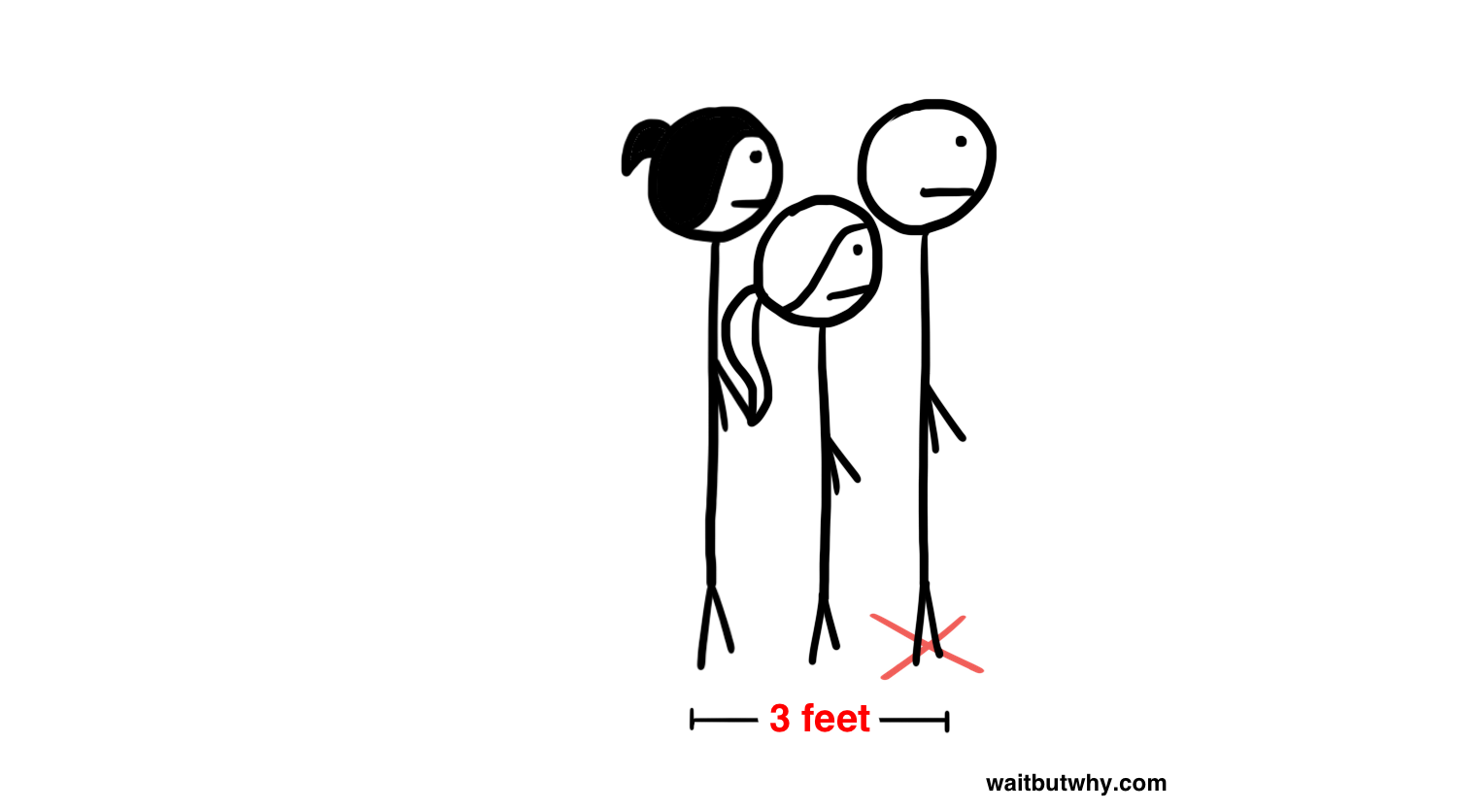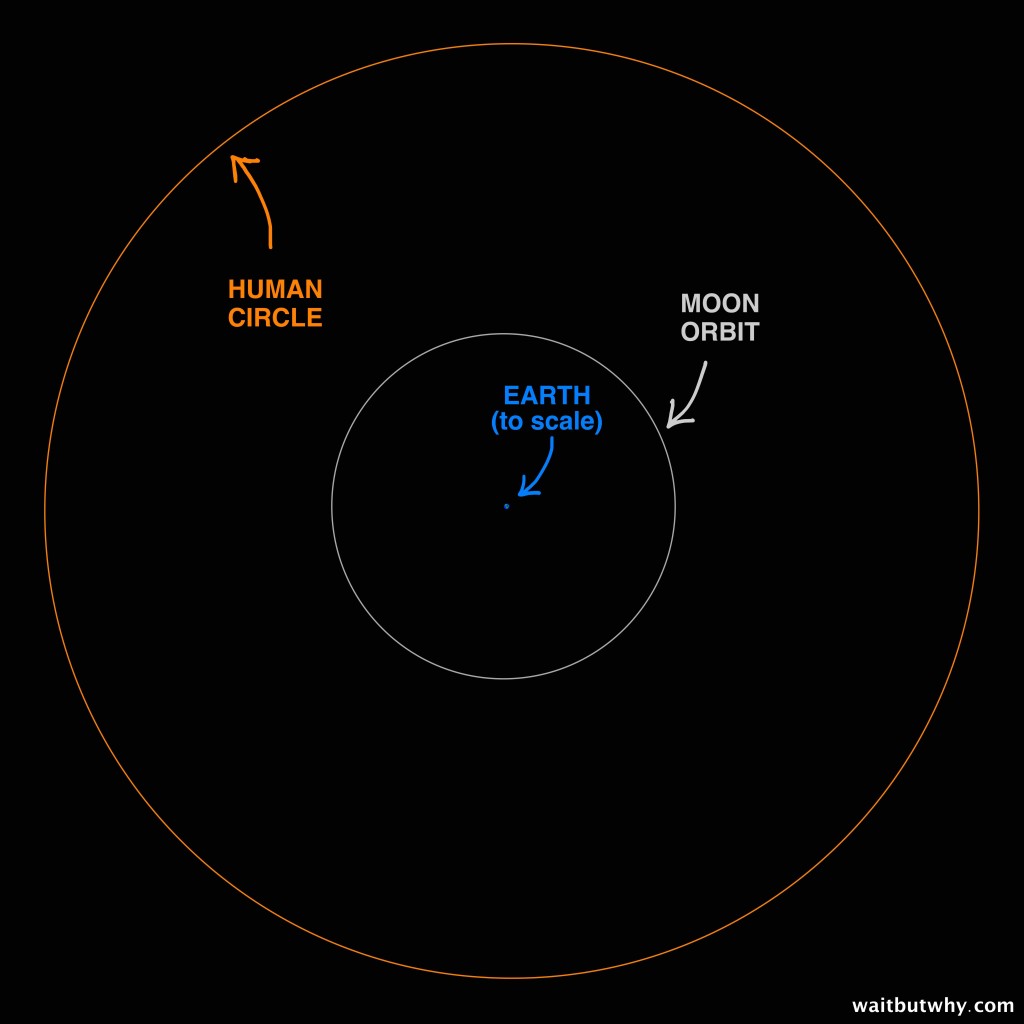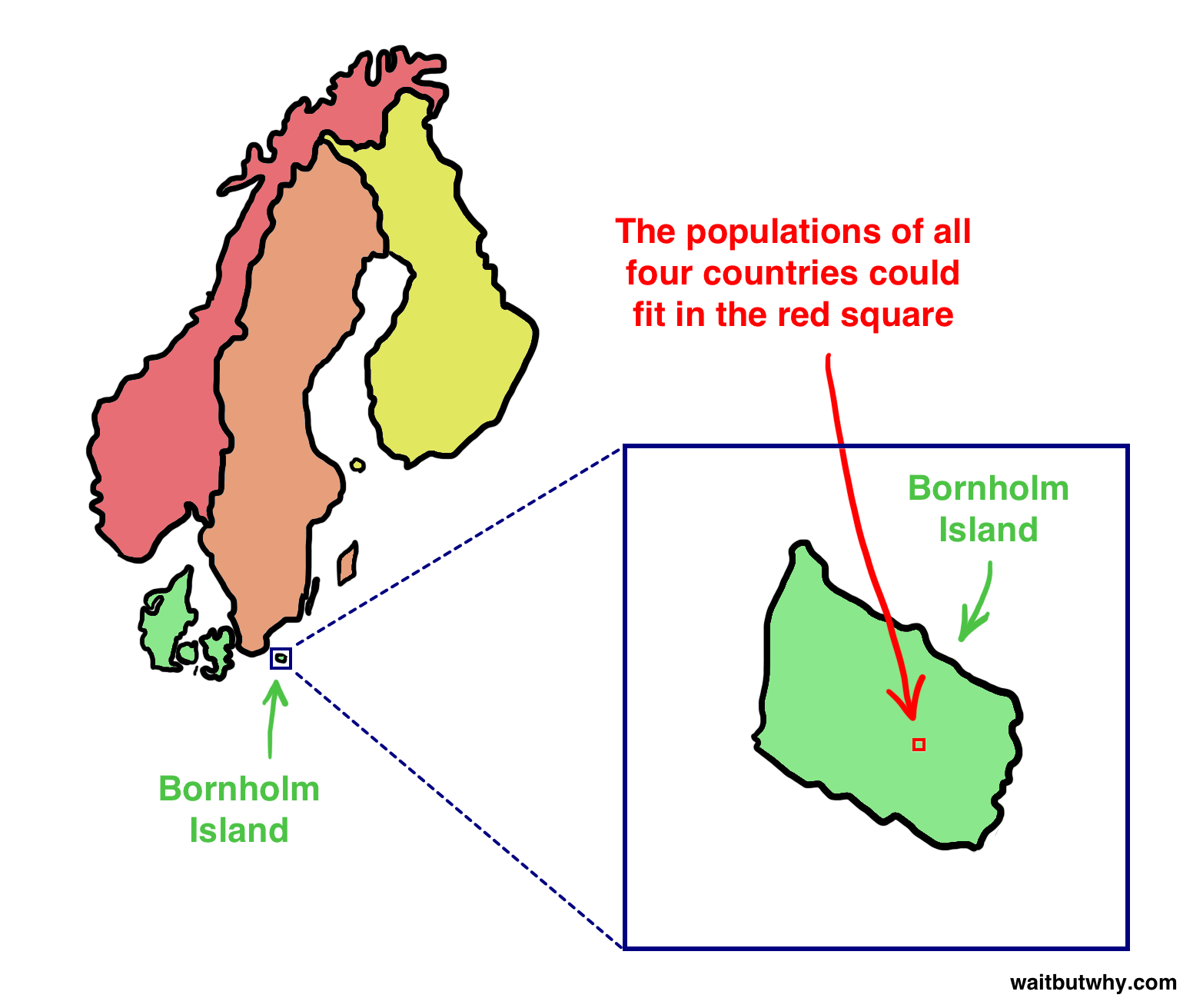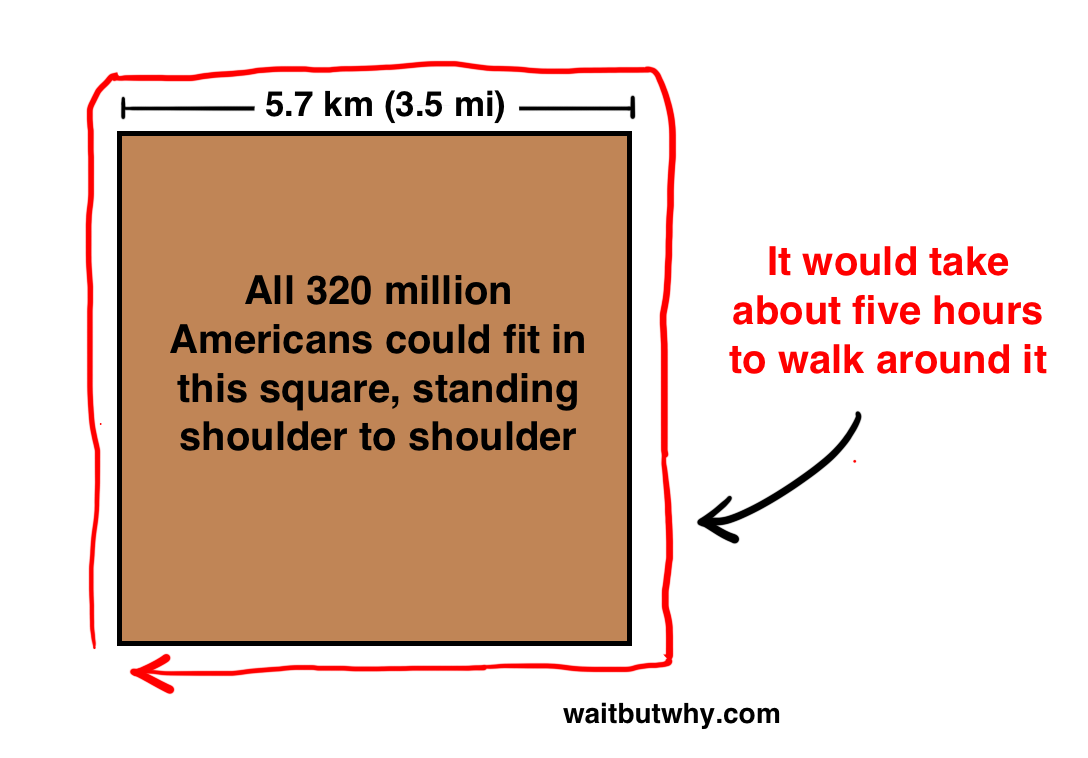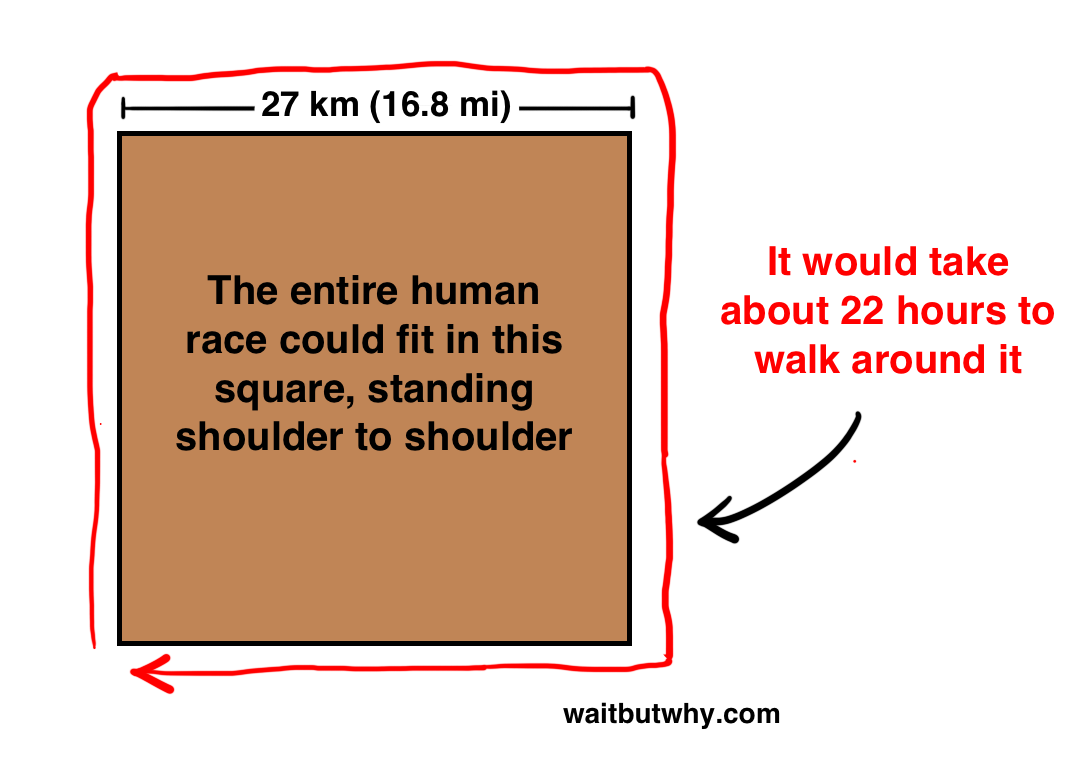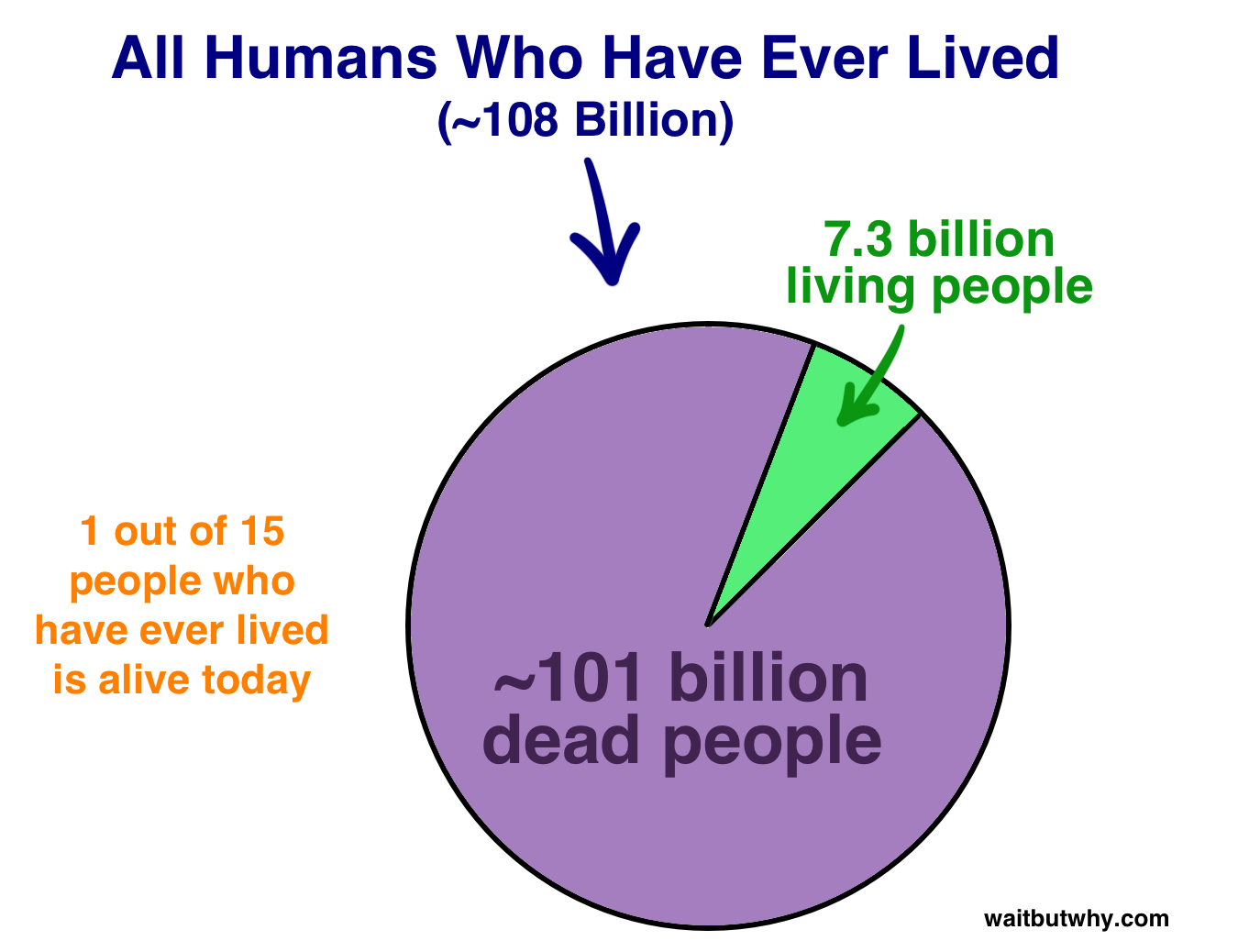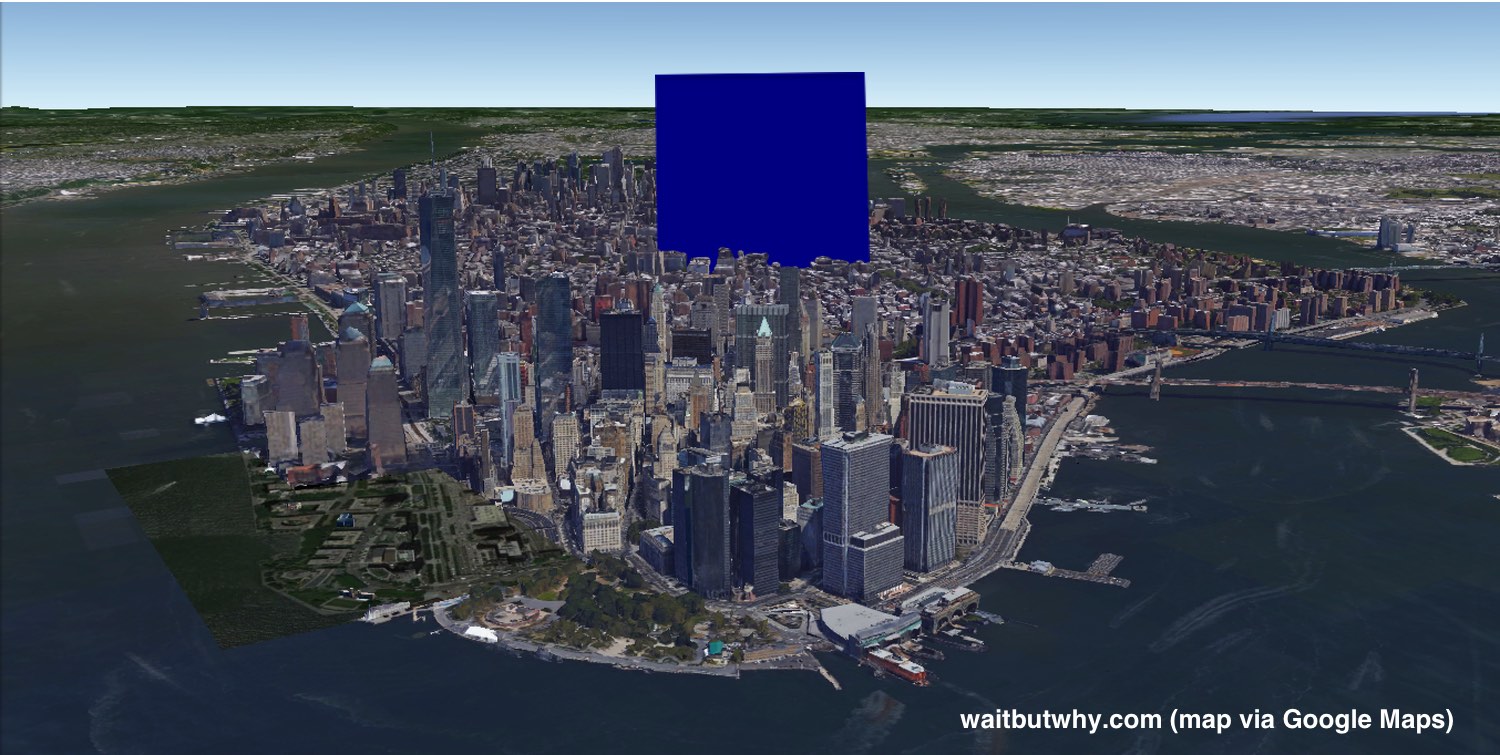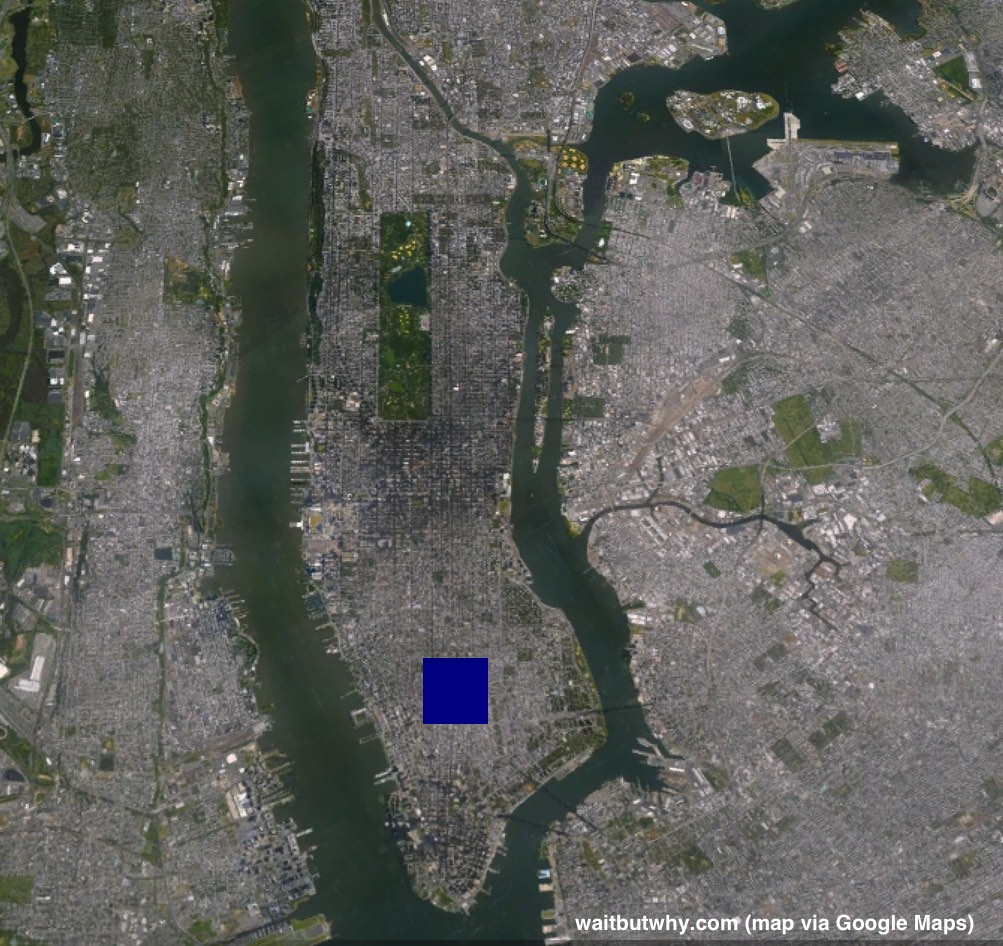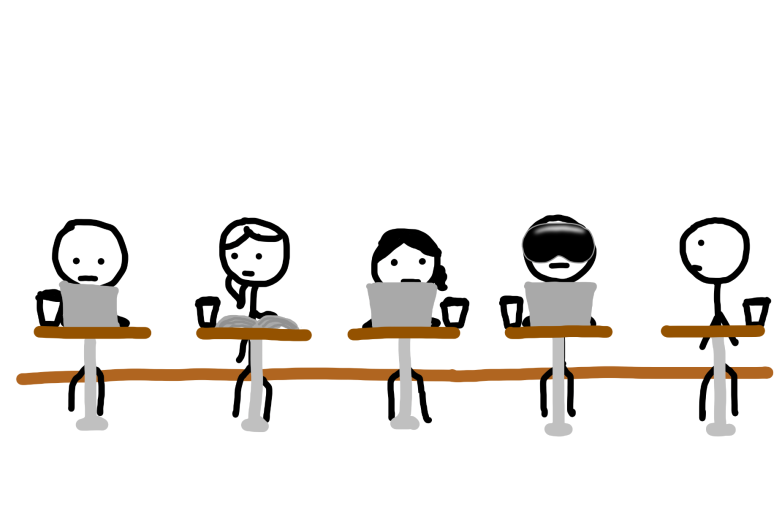After a year and a half of writing Wait But Why posts, I’ve noticed a theme: humans seem to come up a lot.
Sometimes we talk about where humans came from or where we might be going or how we’re all related; other times we look at how we interact and communicate and form relationships. We’ve talked about rich humans and famous humans and baby humans and dead humans and humans from all over the world. We’ve explored what it means to be a human, what it means to be a good human, and whether we’re all alone in the universe. And we’ve spent a lot of time trying to figure out what really matters most in this one, short human life.
But somehow, we made it through all of that discussion without ever asking the most important question of all about humans—
How big a building would you need to fit them all in it?
It’s a question that’s tantalized almost no one through the ages, and today we’re gonna tackle it hard.
But before we ask all 7.3 billion humans to stop what they’re doing so I can arrange and bunch them together at my whim, let’s discuss the number 7.3 billion.
The first thing to note is that when I did a post on population density in August of 2013, the number I kept referring to was 7.1 billion. The world population has grown by 194,000,000, or almost 3%, since then.
Second, 7.3 billion people is a lot of people. If each living human were represented by a dry grain of rice, the rice would fill a cube-shaped box with a side of 6.1 meters,1 or about 20 feet—around the size of a two-story house.
That’s a lot of rice grains.
And how about 7.3 billion grains of sand? Well according to this delightful chart, “sand” can mean a lot of things. 7.3 billion “very coarse” grains (about 2mm in diameter) would fill a large cubic room with a height of 4m (13ft). 7.3 billion medium-size grains (.25mm in diameter) would fill a medium, 46cm high (1.5ft) cardboard box. And 7.3 billion of the finest, .0625mm sand grains (any smaller and it wouldn’t be sand anymore—it would be silt) would take up about 1,700 cubic centimeters of space, almost but not quite filling a 2-liter soda bottle.
Also, walking 7.3 billion steps would take you around the Earth…150 times. (At two steps per second, that would take you 115 years.) (I’m doing that thing where I’m going on divergent math spirals during the post and then just putting what I figured out into the actual post. I’ll try to stay on topic here but it won’t be easy. Let’s keep going.)
7.3 billion humans in one-dimensional configurations
The first activity today will be putting all humans in a single file line. We’ll start near Quito, Ecuador, right on the equator, and the line will follow the equator. We’ll begin with Carlos. Stand here, Carlos.
Second in line will be Daniela. Third is you, Andrea.1 Since we’re trying to be efficient, I want everyone to stand as close as possible to the people in front of you and behind you without actually touching. Some people will require more or less space than others because people are different sizes, but let’s assume each person we add to the line will make the line one foot (about 30cm) longer on average.2
So we do this for a while and the line gets longer and longer. We build bridges over oceans and tunnels through mountains to make a clean line along the equator. Eventually, the line goes around the whole Earth gets back to Carlos. But we’ve only gotten through 131 million people—less than 2% of humans—so we’ll need to wind around the Earth again. And again. Finally, halfway through the 56th loop, on the Indonesian island of Sumatra, we get to the final human, and we’re done.
Okay that kind of annoyed me because it ended up in the shape of spring, not a line. Let’s try another way.
Carlos, stand on the X again. We’re gonna have Daniela stand on your shoulders, and then Andrea’s gonna stand on hers, and we’ll just keep going up from there.
The average human is 165cm (5’5″) tall, but about a foot of that is from the shoulders to the top of the head, so when we add someone onto the top person’s shoulders, the height of the tower rises by an average of about 134cm (4’5″).
We stack and stack and eventually, we reach the moon. Unfortunately, we’ve only used 286 million people at this point and have 96% of humans still left to go. By the time we finally finish, the tower is 9.8 million km (6.1m miles) high, and we’re around 1/5th of the way to Mars, 1/4th of the way to Venus, and 1/15th of the way to the sun.2
How about if we all held hands and formed a huge circle? Let’s say that we’ll stand side-by-side, holding hands, which is enough distance apart to take up about three feet (91cm) of the circle each.
Continuing like this, our final circle has a circumference of 6.6 million km (4.1m miles) and a diameter of 2.1 million km (1.3m miles).
While we’re all out there holding hands and dying instantly from being in space without suits, the Earth will look to us around the same size as the moon usually looks in our night sky.
Okay one dimensional shapes are pretty inconvenient for everyone—let’s reel things in and try this in two dimensions:
7.3 billion humans in two-dimensional configurations
The addition of a second dimension to our human shapes makes the species seem a lot smaller.
When arranging humans in two dimensions, the first question we need to ask is, “How much ground area does each human need when we’re bunching them all together as closely as we can without killing everyone?” The answer, for this post, is .1 square meters, giving us a rate of 10 people per square meter.
How Many People Can Fit in a Square Meter Comfortably-ish?
The quest for this answer brought me to the most obscure corners of the internet, where I came across two key groups of bored people. The first one shows nine Canadian journalists choosing to spend time positioning themselves together into one square meter. Doing so gives each of them an average of one 33cm x 33cm (13″ x 13″) square to stand in. You can see in the video that while it’s definitely tight, no one is forced to molest anyone else and everyone can breathe.
But that’s using all adults. The world’s median age is 29, and the youngest billion humans tend to be quite little. The second case brings us across the world to a random New Zealand elementary school, where a teacher has decided to get cute and cram as many kids as she can into a square meter. She maxes out at a shocking 22 kids.
Putting these two performances together, it seems reasonable to say that 10 humans per square meter is a safe estimate for what we can use as our human-bunching metric. Nine adults in the square managed fine and the addition of children into the mix should be able to easily increase that total by one to 10 (yes, some adults are much larger than average, but others are tiny—the world’s average adult is a not-that-large 62kg (137lb) person).
At 10 people per square meter, we can fit 1,000 people in a 10m x 10m square. A basketball court is 28m x 15m, which means we can fit 4,200 people on one, all in bounds.
We can fit 54,000 people on an American football field, which is large enough to hold the entire population of Liechtenstein or Monaco, and if we expand our field to the size of a soccer field—sorry, a football pitch—we can hold over 71,000 people, more than enough space to contain the population of Greenland.
Tiananmen Square is pretty huge—880m x 500m or just under half a square kilometer.
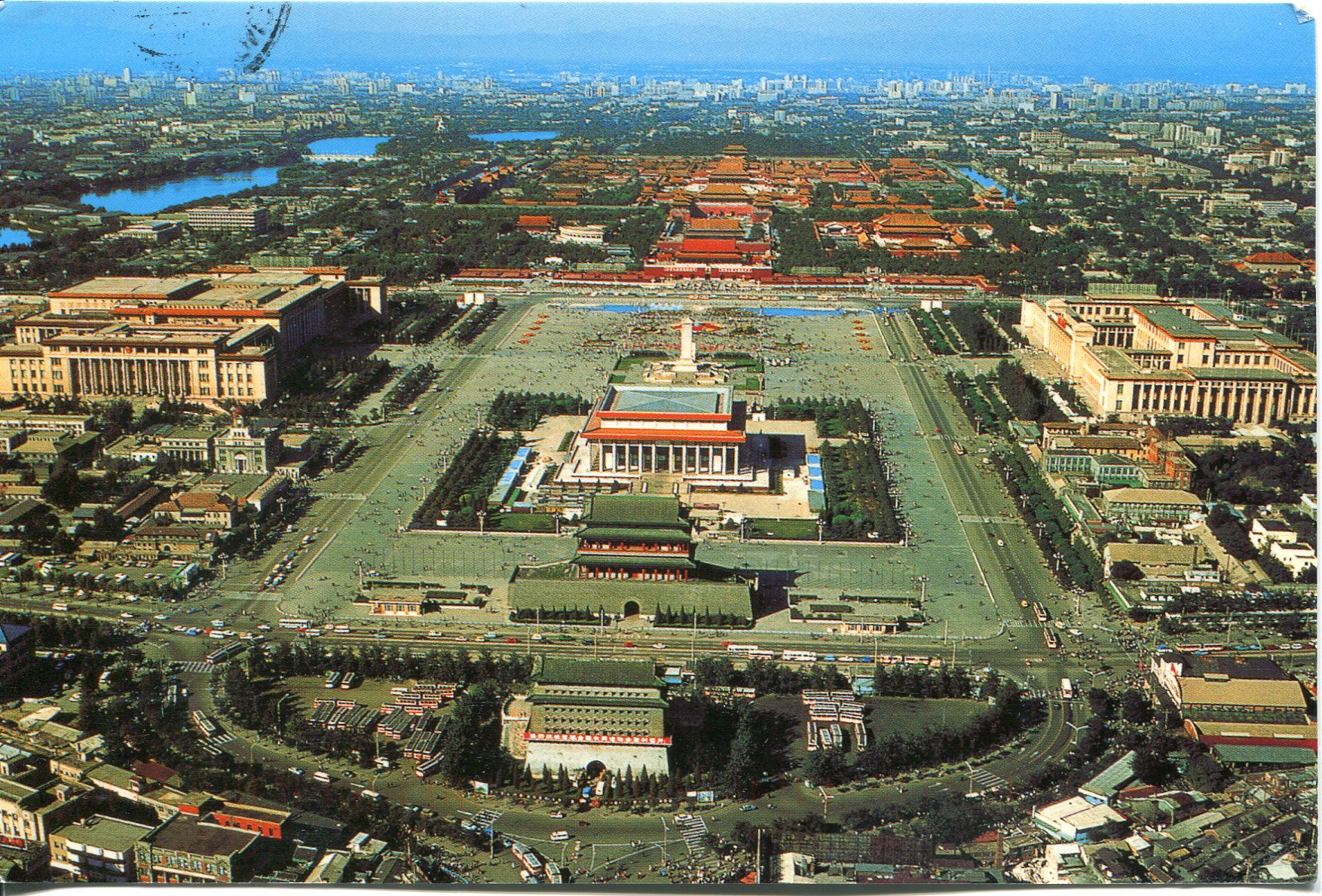
Credit: Keith Higgons
If it were empty, it could hold 4.4 million people, or the entire population of Croatia, Oman, Lebanon, Panama, Moldova, Uruguay, Kuwait, Mongolia, or Lithuania.
A full square kilometer could fit 10 million people—the population of a megacity—and you could pack all 26 million Scandinavians—everyone in Norway, Sweden, Finland, and Denmark3—into one square mile.
Central Park, with an area of 3.41 square km (1.3 sq mi), could easily hold the population of Australia, Morocco, Saudi Arabia, Peru, Venezuela, Malaysia, Nepal, Mozambique or Syria. You could fit all 13.9 million Jews into Central Park and still have room for the population of Romania, Chile, or the Netherlands. The entire human race in 5,000 BC, which historians estimate to be between 5 – 20 million people, would fill up at most a little over half of Central Park.
We’re just getting started, so settle in.
You could squeeze all 320 million Americans into a 5.7km x 5.7km (3.5mi x 3.5mi) square, which would take less than five hours to walk around.
And a square 10km x 10km (6.2mi x 6.2mi), or a small island about twice the size of Bermuda, could hold a billion people (which you could walk the perimeter of in about 8 hours). A slightly larger island, Martha’s Vineyard, has an area of 226km2 and could fit all the world’s Christians on it [insert your own wisecrack here]. Alternatively, Martha’s Vineyard could fit the entire combined population of North America and South America…and still have room for the entire population of Africa. As for the world’s females, if they ever got annoyed with men and wanted to start a club, they could hold their membership-wide meetings in the 360km2 Gaza Strip.
Anyway, what we really want to know is how big a piece of land we’d need to hold everyone—all 7.3 billion of us. And the answer is, a 27km x 27km (16.8mi x 16.8mi) square.
That square is smaller than Bahrain. And on top of Africa, it would look like this:
The square is also smaller than New York City.
NYC has an area of 786 square km, or 303 sq mi, and the whole human race could fit inside it—with room for another half a billion people. Specifically:
- Manhattan could fit 590 million people
- Brooklyn could fit 1.38 billion people
- Queens could fit 2.83 billion people
- The Bronx could fit 1.09 billion people
- Staten Island could fit 1.51 billion people
So let’s try it. First by geographic region:
How’s everyone doing down there?
Great. Now, let’s shift around and organize by religion:
So that’s how much ground space the human race takes up—but that’s only talking about the living humans.
Scientists’ estimates for the total number of humans who have ever lived4 tend to range from 90 to 110 billion people. The most common estimates are around 108 billion total humans. Using that assumption, a little under 7% of all people who have ever lived are alive right now:
We just had a Dinner Table discussion about which dead human we’d like to bring back to life—but what if we brought all dead humans back? How much space would we need to make room for them?
We’d need 10,800 square kilometers—a square with a side of 103km (65mi)—which would easily fit inside Jamaica, Qatar, Kuwait, The Gambia, or Connecticut.
Continuing into hypothetical world, we could fit a trillion people in South Korea, Iceland, Guatemala, or Cuba, and if we covered every square meter of the Earth’s land with people, it would fit 1.48 quadrillion people—200,000 times the current world population. To finish the job, let’s cover the entire surface of the Earth with people—including oceans—to bring the total people that could fit on an Earth-sized planet to a little over five quadrillion people.3
And that’s all fine, but my grandfathers didn’t fight in World War II so I could write posts about two-dimensional things. Time to get in the ring with the big boys.
7.3 billion humans in three-dimensional configurations
Sticking with our 10 humans per square meter of floor metric, we bring height into the equation using the worldwide average human height of 165cm (65in).4 So we can build ourselves a booth with a square meter base and a 1.65 meter height that will fit 10 average humans. This gives us our 3D metric—.165m3/person, or 6.06 people per cubic meter.
When we put lots of people in three-dimensional buildings, we’ll do it by building different height “floors”—some floors would be higher than 1.65m for taller people, others would be shorter than average for shorter people, but each person would be on a floor where the ceiling was just a few millimeters above their head, and the floors would average out to be 1.65m high each.
The Empire State Building has a volume of 1.05 million cubic meters, which when hollowed out and replaced with our new “floors” would hold 6.3 million very unhappy people.
AT&T Stadium, home of the Dallas Cowboys, is a huge domed structure with a volume of 2.94 million cubic meters. With the addition of floors, it could hold 17.6 million people. That’s big enough to fit the entire population of Dallas…plus the populations of New York, Los Angeles, Chicago, San Francisco, and Boston.
The largest building in the world, volume-wise, is the Boeing Everett Factory in Washington State. With a 900m x 495m base (which almost exactly matches the dimensions of Tiananmen Square) and a ceiling over 33m high, the factory’s volume is 13.3 million cubic meters—which we could fit all the world’s French people into with room left over for all the Belgians as well (78.7 million person capacity).
But if we’re gonna fit all of us into a single building, nothing currently on Earth is going to work—we have to build it ourselves.
At .165 meters per person, we’ll need a little over 1.2 billion cubic meters, or just over one cubic kilometer (1.204km3 to be exact).5 This cubic building would have a side of 1.07km (about 2/3 of a mile), giving it a base of about 1.1km—a little over double the size of the Boeing Factory base—and a height of 1,070m (3,511 feet), which is 29% taller than the Burj Khalifa, the world’s tallest skyscraper. That’s a large building, but neither the base nor the height alone are unfathomable by modern architectural standards. Here’s what it would look like if we built it in Manhattan (with other structures added for reference):
Somewhere in that building is you. Somewhere else are all your friends. Somewhere in there is a 16-year-old Cambodian girl and all her friends. Somewhere is a Somali pirate, his barber, and all his barber’s friends. Every NBA player is in there, along with every rockstar, movie star, supermodel, and politician. Every bartender and construction worker and priest and lawyer and prisoner and princess and soldier and dentist are somewhere in that building, along with all 1.4 billion Chinese people, every blond person, and every member of ISIS.
The human race, which seems overwhelmingly large in one dimension when it’s wrapping 55 times around the Earth or forming a circle that dwarfs the moon’s orbit, seems much more manageable when it can fit inside Bahrain or New York City with room to spare and almost quaint when organized neatly into a cube that would take you only 20 minutes to jog around.
And with that, our initial goal is accomplished. But what if, instead of ending this post here, we went just one step further? After all that work, who wants to stop now while there’s still so much empty space in all of our atoms?
7.3 Billion Humans Compressed Down to Their Atomic Nuclei
Every atom’s different, but a general ballpark rule is that an atom’s diameter is about 100,000 times larger than the diameter of its nucleus, the thing that carries nearly all of the atom’s mass. Translated into three dimensions, that means an atom’s nucleus makes up only around one quadrillionth of an atom’s total volume. The way I visualize this is by imagining an atom to be a cubic kilometer—a hollow cube taller than the tallest skyscraper (around the size of our humanity cube above). This building is so large that if you were inside it, hanging from the ceiling, and you let go, it would take you about 15 seconds of free fall before you hit the ground. If you’re standing on one side of the base, it would take you about 12 minutes to walk across to the other.
If that huge cube is an atom, somewhere in the middle is a 1 cm3 sugar cube—and that’s the nucleus. And the atom’s mass would be about exactly the mass of the sugar cube, which takes up one quadrillionth of the total space. Just about all of the other 999,999,999,999,999 quadrillionths of the atom is massless, empty space.
Your body’s mass is the combined masses of the sugar cubes in the middle of each of your body’s atoms.
So how big is the human race really? When we get rid of the empty space in all the atoms of all 7.3 billion people, what are we left with?
An M&M.
Not even, actually. The volume of a human is about .0664 cubic meters, putting the combined volume of all humans at about 485 million cubic meters. When we reduce that to one quadrillionth of its size, we get .485 cubic centimeters. An M&M is .636cm3, about 30% too large. A Skittle is too large too (.74cm3), as are a quarter (.809cm3) and a nickel (.689cm3). It’s pretty hard to find everyday objects as small as .485cm3 (a US penny works, but at .433cm3, falls just short of fitting us all in it).
And that’s where we’ll end things today. With an M&M weighing 450 million tonnes—heavier than 75 Pyramids of Giza—that we could all fit into if someone squished us hard enough.
___________
If you liked this post, here are four more posts in the Pointless Calculations category:
What Could You Buy With $241 Trillion? More cubes. Gold ones this time.
What Does a Quadrillion Sour Patch Kids Look Like? Candy cubes in space.
Putting the world’s oceans, lakes, and rivers in cubes. Water cubes.
What if all 7.1 Billion People Moved to Tunisia? No cubes, but another post experimenting with the human population (less abusive to the stick figures).
_______
If you like Wait But Why, sign up for our email list and we’ll send you new posts when they come out.
To support Wait But Why, visit our Patreon page.
According to this possibly-accurate list of popular Ecuadorian names, Carlos, Daniela, and Andrea are red hot right now.↩
This metric system / non-metric system thing is unbelievably annoying. Almost half of WBW readers are from metric system countries, so I can’t just use imperial units, but a little over half of readers are from the US, so I can’t just use the metric system either, because feet and miles are a bit more intuitive to all those people. So I’ll just put calculations in both systems, which is annoying for everyone—because the US decided to stick with a totally nonsensical system of measurement.↩
Not useful information.↩
Super awkward to start this section with such a mundane sentence after rousing things up so much at the end of the last section.↩
While I was at it, I worked out that to fit all 108 billion humans that have ever lived, we’d need a cubic building with sides of 2.6km.↩
There are about 7,000 grains of rice to a cup, or to 240mL, which translates to 7.3 billion grains filling 251 cubic meters. (In this post, gray square footnotes will be for calculations and other technical details. Blue circles for extraneous thoughts and facts.)↩
At the closest they ever come to Earth, Mars is 33.9 million miles away, Venus is 24m miles away, and the sun is 93m miles away.↩
The definition of Scandinavia is a little confusing. Some people exclude Denmark or Finland, others include Iceland. The most common definition seems to be those four countries.↩
using 50,000 BC as a starting date for humans.↩


